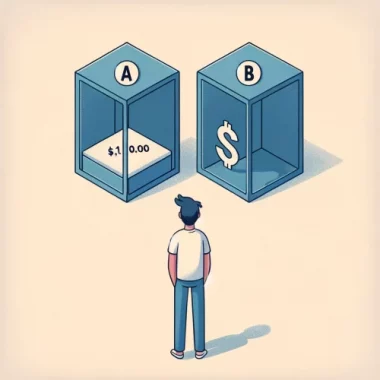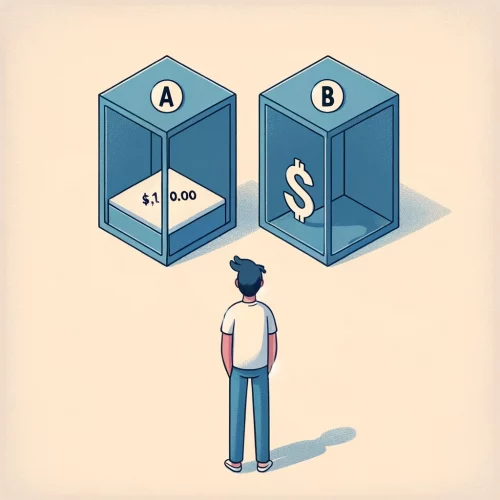
Newcomb’s Problem
What is Newcomb’s Problem?
Newcomb’s Problem is like a game where you have to make a big decision, and the right choice isn’t easy to see. Imagine someone really smart, called the Predictor, who has guessed what decision you will make. Now, there are two boxes in front of you. The first box is clear, and you can see it has $1,000 inside. The second box is not see-through, and it might have nothing or it might have $1 million in it. If the Predictor thought you would take both boxes, they left the second box empty. But, if they guessed you’d only take the second box, then it’s filled with $1 million.
Imagine being in this game. You’re told the rules and have to decide. Do you take both boxes and get the sure $1,000 plus whatever is in the second box (which could be nothing)? Or do you just take the second box, betting on the chance to get $1 million, trusting that the Predictor knew you would do just that? This is Newcomb’s Problem. It’s hard because one part of your brain tells you to grab everything, but another part wonders if the Predictor is usually right, shouldn’t you just take the second box for the big money? People have been arguing about what’s the smartest choice since 1969 when a guy named Robert Nozick made the problem famous.
This puzzle isn’t just for fun; it makes you think deeply about how we make choices when we’re not sure what will happen. It’s like choosing between a sure thing and a gamble, and it makes us ask questions about whether we really can make any choice we want or if everything is already decided for us somehow.
Simple Definitions
To help us understand Newcomb’s Problem, let’s break it down into two simple ideas:
- The Dominance Principle is like always picking the choice that seems best, no matter what else is going on. Think of it as choosing the safest bet in a risky game.
- The Expected Utility Principle is more about taking a chance if you think it could lead to a much better reward. It’s like if you have a feeling that something great is likely to happen, you might risk a sure thing hoping for an even bigger win.
These two ideas bump heads in Newcomb’s Problem because the Dominance Principle says take both boxes to make sure you get something, but the Expected Utility says if you have reason to believe that the Predictor is right, go for the bigger prize in just one box.
Key Arguments
- The Two-Box Argument: This idea says you should pick both boxes. Take the sure $1,000 plus any chance of finding something in the second box. The Dominance Principle backs this up because this choice seems better, no matter what.
- The One-Box Argument: This side bets it all on just the second box. Since the Predictor is almost always right, going for this could mean hitting the jackpot with $1 million. The Expected Utility Principle supports this choice, thinking about what could happen and suggesting it’s the smart move.
- Determinism vs. Free Will: The problem also makes us wonder if things are set to happen a certain way (determinism) or if we can really make any choice we want (free will). If you believe we’re all free to choose, maybe the Predictor’s guesses seem less sure, and you might lean toward grabbing both boxes. But if you think everything is set and the Predictor can indeed predict, you might just take one box.
Examples
- Imagine you’re on a quiz show and there’s a prize behind one of two doors. One door is slightly open, so you can see a smaller prize. A host who is known for guessing contestants’ choices tells you that if he thought you would pick both doors, the second door has nothing. This is Newcomb’s Problem because you have to choose between the safe small prize and the potential big prize, questioning the host’s ability to guess your decision.
- Think about saving money versus spending it. Saving is the safe $1,000, while spending on an investment is like the mystery second box—it could lead to a lot of money or might bring no extra value. This reflects Newcomb’s Problem by making you decide between a sure thing and a possible major gain based on predictions about the future.
- A coach decides whether to play a solid but less spectacular player (the sure $1,000) or give the chance to a new talent who could be a star or a flop (the mystery second box). This situation echoes Newcomb’s Problem by presenting a choice between reliability and potential greatness.
Why is it Important
Understanding Newcomb’s Problem isn’t just for brainy debates; it hits close to home. We face decisions like this all the time in life, where we weigh guaranteed results against bigger dreams. If you can grasp this problem, it can help you make smarter choices in real life, like when saving money, making plans with friends, or even deciding what game strategy to use when you’re playing with others.
For the average person, it’s about knowing when to play it safe or when to risk it all for a big win. Understanding this can help not just with personal decisions but also in understanding how businesses, governments, and even your favorite sports teams make their moves.
Major Criticism
The big sticky point with Newcomb’s Paradox is this idea of a Predictor that can almost see the future. Critics say that’s just not possible because people are full of surprises and do things no one can guess. And because we can’t actually test this game in real life, some people shrug off the whole paradox as a fanciful idea that’s just for thinking about, not for using in everyday decisions.
Practical Applications
Even though Newcomb’s Paradox seems like it’s all in our heads, it actually tells us a lot about the funny ways we decide things when we’re unsure. Here are a few reasons why it’s more than just a puzzler:
- Behavioral Economics: The paradox shows us that we don’t always go for the logical choice, and it gets us thinking about what we want right now versus what could be better for us later.
- Game Theory: It puts classic game rules to the test, especially the idea that we should always pick the option that seems best in every situation.
- Predictive Modeling: It also could help scientists design experiments to check how good computer programs are at guessing what people might do, even though we don’t have a real Predictor like in the game.
In essence, Newcomb’s Paradox is this cool puzzle that connects real-life decision making with deep thoughts about knowing the future and whether our choices are truly our own. Even though it’s a bit of a brainteaser, it puts the spotlight on the tricky choices we all face when we’re dealing with things that are uncertain and unknown.
Related Topics
- Game Theory: This is the study of strategic decision making. Newcomb’s Problem is related to game theory because it involves choosing strategies to maximize your benefit based on how others might act.
- Free Will vs. Determinism: These are two big ideas about how much control we have over our actions. Newcomb’s Problem makes us think about if our choices are really up to us or if they are predicted by some rules of the universe.
- Behavioral Economics: This blends psychology with economics, looking at why people make the financial choices they do. Newcomb’s Problem is connected because it looks at why people might or might not take a sure thing when there’s a chance for more money.
Conclusion
Newcomb’s Problem challenges our brains to look at how we make tough choices. It’s like standing at a crossroads where one path is safe and well-lit, and the other leads into a dark forest with hidden treasure. The discussions about which path is smarter to take have been going on for more than 50 years, and they aren’t just for thinkers and dreamers. These conversations can shine a light on how we all figure out what to do when life gives us a tricky choice. By wrapping our heads around this puzzle, we better equip ourselves for the decisions we make every day.
